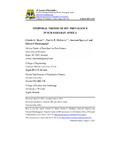TEMPORAL TRENDS OF HIV PREVALENCE IN SUB-SAHARAN AFRICA
Date
2023-08-04Author
Mutai, Charles K.
McSharry, Patrick E.
Ngaruye, Innocent
Musabanganji, Edouard
Metadata
Show full item recordAbstract
Background. The HIV epidemic varies significantly across different groups in the SSA region, and complicates designing effective general interventions. We aim at uncovering temporal trends in HIV prevalence disaggregated by age, sex, and country.
Method. We determined HIV prevalence trends among males and females aged 15-49 years for surveys conducted from the years 2003-2007 (period 1) and 2013-2018 (period 2) in SSA. Countries were divided into three clusters based on their socio-behavioural characteristics, and age was categorized into ranges of 15 to 24 years, 25 to 34 years, and 35 to 49 years. A log-binomial regression model was employed in testing for a discrepancy in prevalence between these groups.
Results. Swaziland had the highest increase in HIV prevalence between the two periods among females, with a 3.18% rise, followed by Lesotho, Ethiopia and Tanzania females with 2.96%, 2.18% and 0.05%, respectively. Men of ages 15 and 24 experienced an increase from 0.29 (95% CI 0.1-0.84%) to 0.32 (95% CI 0.15-0.68%), 0.36 (95% CI 0.18-0.73%) to 0.47 (95% CI 0.32-0.7%) between the two periods in Cote d’Ivoire and Rwanda, respectively. Females of age 25 to 34 in Ethiopia had an increase in the prevalence of (3.26 (95% CI 2.6-4.08%) to 4.25 (95% CI 3.47-5.21%)).
Conclusions. There is a significant difference in HIV prevalence in the general population between the sexes and age categories. In general, females outperformed their male counterparts in every category.
URI
https://doi.org/10.17654/0973514323015https://pphmjopenaccess.com/index.php/jpjb/article/view/939
http://ir-library.mmust.ac.ke:8080/xmlui/handle/123456789/2672
Collections
- Gold Collection [990]

